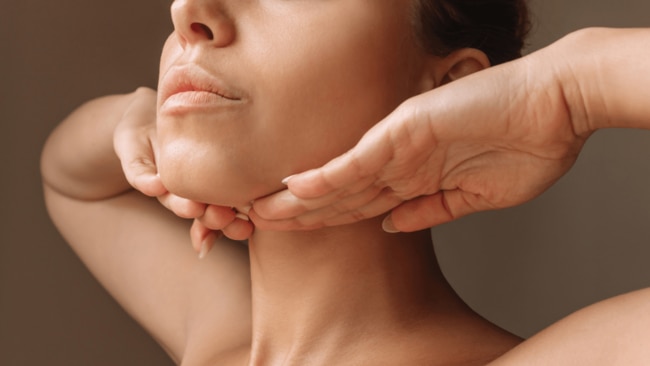What is ‘mewing’? The viral jaw shaping hack has doctors scratching their heads
The modelling world’s worst kept secret

Lifestyle
Don't miss out on the headlines from Lifestyle. Followed categories will be added to My News.
Social media is full of people showing the dramatic changes to their jawlines after mewing. But what is the orthotropic technique, and is it safe?
In the space of a few years, many of us have taken on a new insecurity we hadn’t anticipated – the softness of our jawlines.
Despite approximately 30 percent of adults experiencing Temporomandibular Joint Disorders (TMJ) or jaw tension at some point of their lives, our jawlines still don’t feel strong enough.
Enter mewing – the hack you’ve seen all over social media, promising a jawline that could cut glass.

What is mewing?
In the age of looksmaxxing, jaw-defining treatments including filler and jaw shaving surgeries have been gaining popularity. Creators online claim mewing is the easy hack to define your jaw treatment-free.
It involves pressing your tongue to the roof of your mouth with your teeth lightly touching and your mouth closed. You then suction your tongue upwards and hold this position for a set length of time before releasing.
The jaw training technique was developed by controversial orthodontist John Mew and targetted at young men wanting a more chiselled jaw.

You may have heard rumours of models mewing to lift the area under their chins and highlight their jaw bones.
There are countless videos online of people showing off the noticeable changes to the their jaws and teaching us how to get the model look through the technique. But the effectiveness of the technique is up for debate.
Experts aren’t sold on mewing
The orthodontist behind the hack was removed from the British Orthodontic Society after he spent years promoting the technique.

Good oral posture is important to breathe, swallow and bite properly, and involves typically unconsciously resting the tip of your tongue on the roof of your mouth behind your front teeth. But unlike mewing, there shouldn’t be a feeling of suction or muscle tensing.
Many dentists warn against mewing, as there isn’t any reliable scientific evidence supporting it’s effectiveness.
It could also exacerbate symptoms of existing jaw issues.

Speaking to Women’s Health, facial plastic surgeon Dr Donald B. Yoo said “Mewing results in forcefully pressing the tongue against the roof of the mouth repeatedly and frequently, which promotes an unhealthy range of motion within the TMJ (temporomandibular joint), which can lead to discomfort, pain and even difficulty chewing normally".
“It can also exacerbate a mismatch in the alignment of the teeth and jaws, creating uneven wear of the teeth, teeth grinding, and even a bite that does not close completely."
Some of us naturally have softer jawlines
Our faces can change with age, particularly in adolescence, so it makes sense for young men to see their jaws grow more snatched.

But while some people may see an immediate change in the appearance of their jawline when pressing their tongue to the roof of their mouth, others simply don’t have the facial structure to achieve this, and won’t see a change no matter how much they try to strengthen the muscle or change their oral posture.
Thumb sucking, sleeping with your mouth open, and an overbite can also impact the look of your jaw, and mewing definitely isn’t a treatment for any of these.
If you’re concerned your jaw is misaligned or experience jaw pain, orthodontists can help through treatments with proven success, including surgery, braces, or injectable treatments.
Our faces aren’t all meant to look the same and we’re not all meant to have the most square chiselled jawlines, so it may be time to give your facial muscles a rest.
More Coverage
Originally published as What is ‘mewing’? The viral jaw shaping hack has doctors scratching their heads





